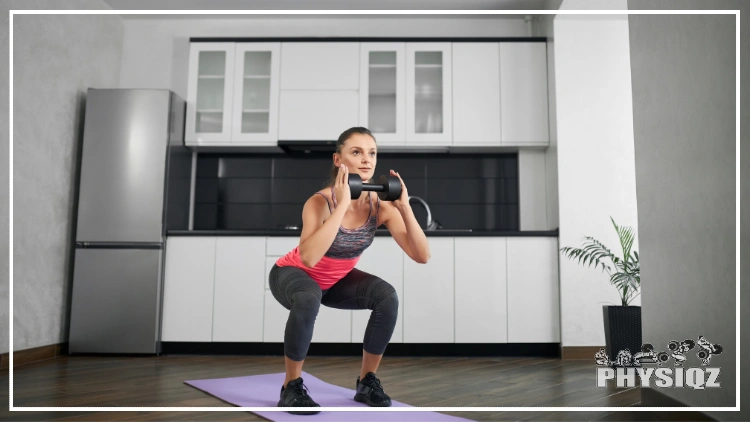
Learning how to increase leg muscle mass for skinny girls can transform shapeless legs into fuller, thicker limbs that enhance your figure and boost your confidence.1
Luckily, bigger legs for females can be achieved fairly quickly in just 4 simple steps such as choosing the right exercises (gym exercises and cardio), hitting them hard enough (frequency and intensity), allowing the right amount of recovery, and of course getting enough nutrients such as calories and/or macronutrients.
While these steps may be simple in theory, doing them consistently and properly is another story. But don’t worry because we’ll guide you through the process every step of the way.
4 Steps for Skinny Girls to Build Muscle in Their Legs
While targeted weight loss and gain are not a real thing, it is possible to increase muscle mass in certain locations and these 4 steps are the ultimate way to begin a leg transformation.
It may seem like certain ladies are just doomed to genetically slender gams, but a specific and well structured workout along with an appropriate diet is the ultimate combination to start seeing big changes in a short time.
Step 1: Choose the Right Exercises (Exercise Selection)
Choosing the right exercises is imperative to pinpointing change; instead of performing hours of workouts that are counterproductive to supple calves and thighs, the below exercises are how to get bigger legs for females in the most productive way.
Not only will we provide exercise selections that consist of compound and isolated movements, but also a complete workout program that can aid in building a routine.
Compound Exercises for Thick Legs (Thicc Legs)
These are multi-joint movements that give you the most bang for your buck since they work out several muscle groups and also provide more positive hormonal responses than isolation exercises.
Bodyweight Squats: Adding squats into a gym routine is an impeccable way to see results and can be the best place to start to make sure it can be done with good form.
Not only do squats work out the quadriceps and hamstrings, they also condition the calves, glutes, and all the small muscles around the hips as well as all the other supporting lower body and core musculature.
Barbell Front Squat: A front squat includes a barbell that rests on the top of the chest and shoulders and is held in place by the hands which are positioned below the bar while the triceps are parallel to the ground. This particular version is not only great for the legs, but core strength as well.
Barbell Back Squat: Back squats are where a barbell rests on the top of the back and shoulders and is steadied by both hands. This exercise allows lifters to utilize the heaviest loads and should be the focus of any workout regimen as long as it can be done safely and with great form.
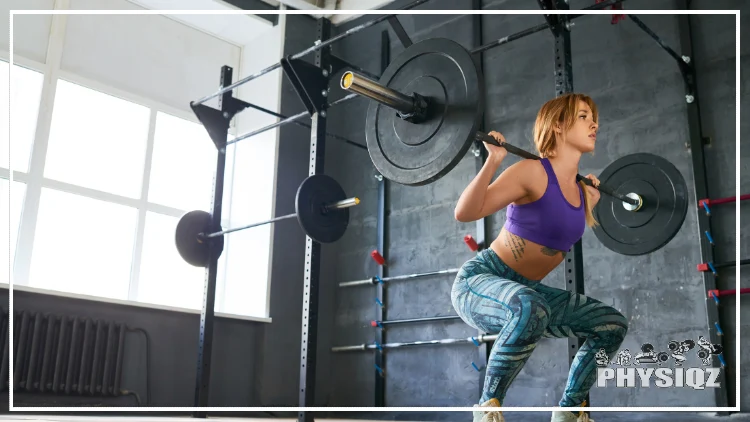
Source: mediaphotos via Canva.com2
There are several various types of squats but a majority start with feet shoulder width apart and toes pointed forward; when squatting down, the thighs should be parallel to the ground, then complete by returning to the standing position.
Regardless of whether the easiest or hardest variation of squat is being performed, the most vital thing to remember is keeping the proper form. Not only will proper form aid in muscle development, it will also prevent injury.
Bodyweight Squat: The most basic version of a squat, this is done without any weight or added movements.
Jump Squat: For added mobility, a jump squat starts with a typical bodyweight squat and ends by propelling into a jump from the squatted position.
Dumbbell Squat: A dumbbell squat utilizes a choice of dumbbell weights which can either be held down by the squatters sides or up near the head with the end of each weight on each shoulder.
Goblet Squat: Extra core strength can be gained by performing the goblet squat by holding a dumbbell vertically by the weighted end near the chest during the exercise.
Lunges: While squats work the same muscles with each motion of the exercise, lunges target certain muscles in the right leg while different muscles in the left leg are working and vice versa.
There are many variations of lunges, but they all focus on the large muscles of the legs as well as peripheral muscles. Regardless of the different varieties of lunges, whichever one chosen will contribute to both strength gains in the legs and core muscles while aiding balance.
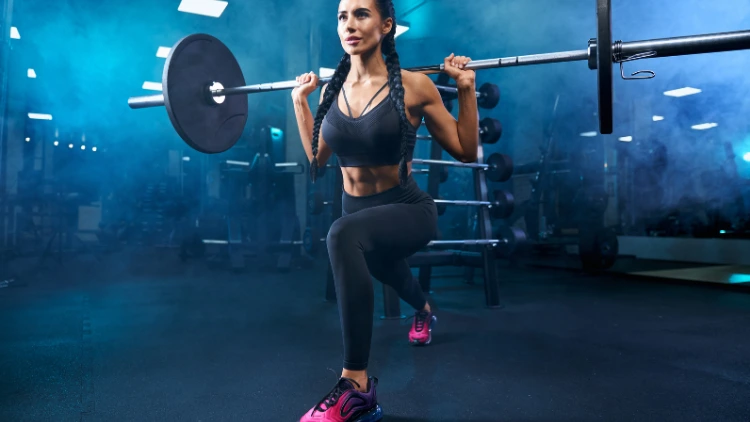
Source: Зображення користувача SerhiiBobyk via Canva.com3
Backward Lunge: The perfect lunge for beginners, this lunge doesn’t take quite as much balance as other lunges but still works the large muscles of the legs along with the glutes and core muscles.
Standing with feet together, take a step backward and while keeping the hips and back straight, bend both knees until they reach a 90 degree angle then return to starting position.
Side Lunge: Instead of stepping backward, the side lunge requires stepping to the side and only bending the active leg. This motion works leg muscles along with core and hip muscles.
Forward Lunge: A more advanced lunge, the forward lunge requires the most balance because the body’s center of gravity is constantly being pushed forward. While this is excellent for building core strength, it is important to concentrate on correct form.
Weighted Lunge: As lunges become easier, adding weights to increase difficulty can add to muscle gains. This can be done with dumbbells held to the side, a single dumbbell held as a goblet, or a barbell in the same hold as back squats.
Deadlifts: Although there isn’t as much movement as squats or lunges, deadlifts are an impeccable way to build muscular legs. Most have heard the saying “lift with your legs” and this is the core basis of this exercise.
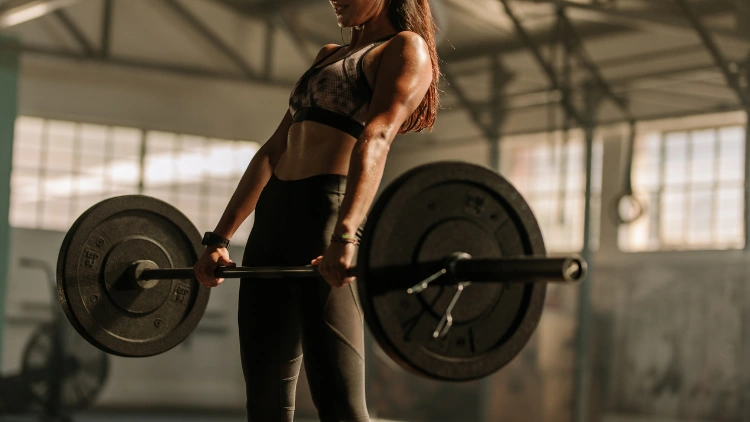
Source: Jacob Lund via Canva.com4
As with most other exercises, there are many versions of the deadlift, but all variations, including the ones listed below, work the quads, hamstrings, calves, glutes, as well as smaller muscles so they’re perfect for skinny girls learning how to gain weight in their legs.
Traditional Deadlift: Keeping the back straight and feet shoulder width apart, bend at the hips until the shoulders are over the barbell, then, hinge the knees until the bar can be gripped from the outside of the legs.
When lifting, it is imperative to use the legs to push up and lift the weight from the floor; this will prevent injury and promote muscle gains.
Romanian Deadlift: Also known as the stiff leg deadlift, the Romanian Deadlift requires less bend in the knees and a stance that pushes the shoulders out further in front of the barbell. While this particular exercise still works the large muscles of the legs, it focuses on the hamstring and glutes.
Sumo Deadlift: If the above deadlifts feel intimidating, a great beginner exercise is the sumo deadlift because there are less complex movements which allow for more concentration on form.
Instead of having feet slightly parted, they will be out past the shoulders with feet at a 45 degree angle.
Now, when squatting down to reach the bar, the arms will be between the legs and not on the outside which puts less strain on the back.
Isolation Exercises to Gain Weight In Skinny Legs
Isolation exercises well, isolate certain muscle groups but they’re a perfect additive to any workout program and should normally be done after all compound exercises since they’re less taxing and you can’t move as much weight with these moments.
Leg Extensions: When looking to work the quadriceps alone, there is nothing better than leg extensions.
Many may think of the quadriceps as a singular muscle, but in reality, it is a muscle group that contains 4 individual muscles that operate the knee and allow the leg to hinge at the hip and can be grown by this particular resistance exercise.5
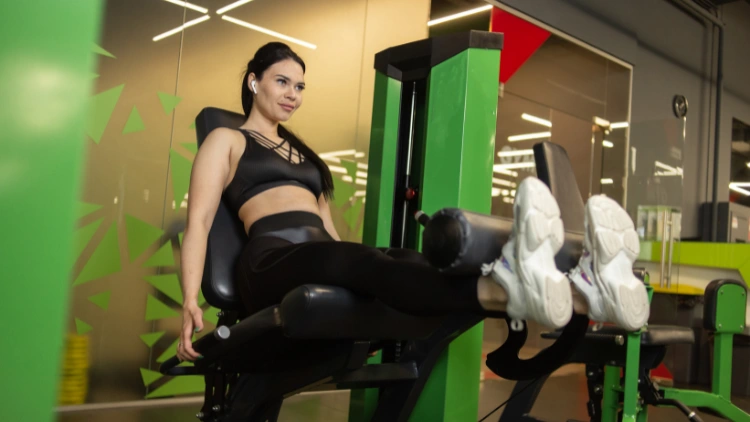
Source: vladimirsukhachev via Canva.com6
Leg extensions are typically performed on a weight machine that require the user to be sitting. The weight is focused evenly over the ankles and each repetition requires a full extension of the leg and subsequently returning back to the starting point.
It is important not to overload weight because it could have a negative impact on the knee joints.
Leg Curls: There are a multitude of ways to do a leg curl, but because this is an isolation exercise, regardless of which version is performed (sitting, laying and banded are most common), the hamstring is getting the benefit.
This grouping of 3 muscles is located at the back of the thigh and helps in knee flexion as well as allowing the leg to extend behind the body.7
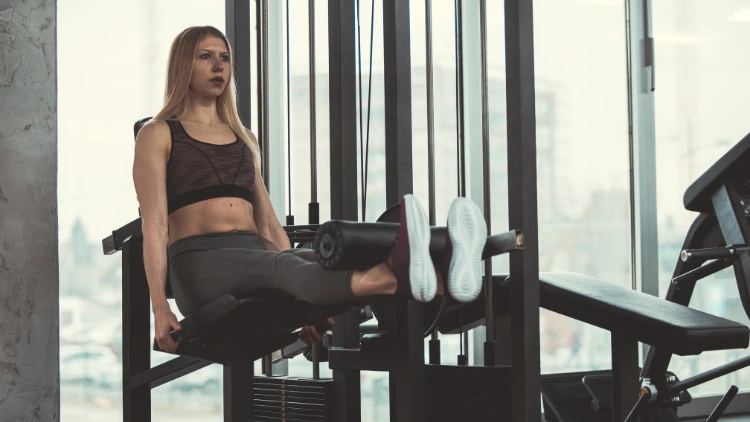
Source: fotostorm via Canva.com8
Leg curls work out hamstring muscles by focusing weight right behind the heels. As the knee is bent, regardless of the curl machine used, the hamstring will do the bulk of the heavy lifting, thus building muscle.
Calf Raises: Tips for helping a skinny girl gain weight in her legs must include exercises for calf muscles, as having shapely and defined calves will balance the appearance of the leg and make it look strong and muscular.
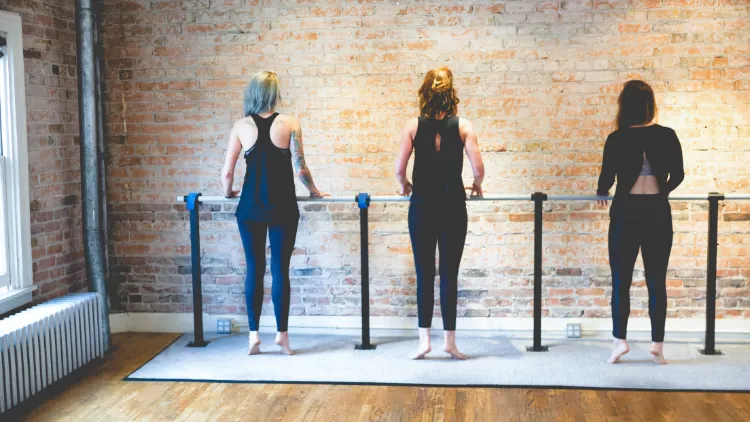
Source: grandriver via Canva.com9
The calf muscles help bend and flex the ankle and can easily be worked out with calf raises.
The calf raise can be performed just using body weight and as strength progresses, adding weight with a machine, barbell, or dumbbells can promote tone calves. Note, normally it’s best to stand on something when doing calf raises to ensure you get a full stretch at the bottom.
Step 2: Workout Your Legs the Right Amount & Let Them Recover (Get Enough Volume & Rest)
Working out your legs the right amount is vital to muscle growth, but letting them recover is just as essential. Getting enough volume(sets) and rest may take a bit of trial and error, but it is worth the effort if gains are trying to be made.10
Underworking muscles will prevent them from developing and overworking them will cause them not to recover properly, which will also limit growth. This goes for time between sets and number of days between workouts.
The amount of time between each set is less about a specific timeframe and more about feeling ready to complete another set. Once the active muscles aren’t still feeling overly fatigued from the last set, it’s ok to move to the next.
As for the amount of time between leg workouts, 1 to 2 days is sufficient depending on how many sets and reps were done. The less sets per day, the likelier it is that waiting a day between sets is enough.
Structuring workout days based on the amount of sets per day is a good rule of thumb.
For those wondering if training legs three times a week is excessive, the table below outlines the recommended weekly sets for each muscle group. Anything over these numbers begins to hinder recovery time and muscle growth.11

Step 3: Eat Enough Food to Build Bigger Legs (Eat Healthy Too)
Another big component in figuring out how to get bigger legs for females is how to eat enough healthy food to build muscle. It may be shocking to hear and counterintuitive to all trending diets, but to achieve beautifully strong and sculpted legs, eating at a calorie surplus is necessary.
Some women may find this way of eating difficult, but filling the right mix of calories and macros with healthy choices is the key to success.
Get Enough Calories
Muscles have mass and when muscle is gained, weight is gained at the same time. To build this muscle, there must be a calorie surplus to add to that mass.
Finding out maintenance calories is critical when estimating how much of a surplus the body needs to put on muscle because not enough calories will prevent muscle gain and too many calories will result in weight loss.
Building muscle on maintenance calories is possible in certain cases, but it’s generally not very effective.
Using the Body Weight Planner is a good place to start when planning calories.12 It takes the amount of movement performed in a day and estimates how many calories are needed to maintain current weight.
To determine a surplus, begin by adding 200 to 300 calories per day. Unfortunately, there is no magic formula or number that will give exact numbers; in fact, formulas and estimates can be off by hundreds of calories because each individual is different.
So, the best way to know if the surplus estimate is working is by body weight tracking.
To successfully track, record weight on a weekly basis at minimum.
If weight is being lost or maintained, more calories should be added, if a significant amount of weight is being gained, calories should be reduced; but, if just a small amount of weight is being gained on a weekly basis, the amount of calories eaten is spot on.
Consider Tracking Your Macros
While calorie intake is crucial, the source of those calories is just as important when trying to increase leg muscle mass for skinny girls. Determining the right amount of protein, carbohydrates, and fat is essential for muscles to reach their full potential.13
Protein: Protein is essential for a majority of the body, including its multitude of organs and adding thickness so consuming the correct amount of protein is a must when trying to build skeletal muscle because they are at the bottom of the priority list when protein is doled out.
Research has shown that 1 gram of protein per pound of body weight is the sweet spot for maximizing its benefits. But .8 grams of protein per pound of body weight is sufficient for most.
Carbohydrates: Carbs may be a scary word for many to hear, but when it comes to bulking up, it is a necessity. Not only do they provide energy, they also aid in muscle recovery as well.
Depending on the workload in a day, 1 to 2 grams of carbs per pound of body weight is sufficient. Or, instead of working out the exact amount of carbs, focus on getting the correct amount of fat and fill the rest of the calories for the day with carbs.
Fat: Healthy fats are very important, but too much fat goes straight to storage and doesn’t have as many benefits as protein and carbs. Too little fat can cause mood swings, depression, and a decrease in testosterone (which is critical for both men and women).
A good starting place to estimate fat needed is .4 grams per pound of body weight and can be adjusted slightly if needed.14
Note, fats are essential for many bodily functions and carbs provide sustained energy, but to gain weight in the legs and get more muscle on your frame, the most important things are:
- Being in a surplus of calories
- Eating about 1g of protein per lb of body weight
- Getting enough fats which most will do without even trying
Don’t focus on carbs very much unless you’re trying keto or low carb, but that’s an entirely different approach. Of course, keto can aid in weight loss or even weight gain, but cutting out carbs isn’t necessary since calories in vs calories out is more important.
Make Healthy Choices Overall
Now that the macros have been worked out, using the proper foods to fill protein, carbs, and fats will maximize the benefit of this way of eating.
Try to avoid foods with added sugar, white flour, and other heavily processed foods. Choosing lean meats, whole grains, and healthy fats is the ultimate way to get stellar legs.
- Boneless Skinless Chicken Breast
- Ground Turkey
- Lean Beef
- Fish (Tuna, Salmon, Tilapia, etc.)
- Eggs
- Beans
- Vegetables
- Fruit
- Brown Rice
- Quinoa
- Oatmeal
- Sweet Potato
- No Sugar Added Peanut Butter
- Avocado
- Yogurt
Step 4: Choose Cardio Exercises That Promote Thicker Thighs & Calves
Strength training is obviously a great starting point for how to get bigger legs for females, but the cardio exercises performed in weekly workout routines can also benefit muscle growth and development.
Looking around at athletes, pinpointing which cardio exercises that bulk up legs might be obvious. Cycling, running, swimming, and the stair climber all put a big focus on the large muscles of the legs and can help achieve cardio and muscle building simultaneously.
Workout Plan for Skinny Girls To Get Thicker Legs (Exercises To Get Bigger Legs for Females)
Instead of starting a workout plan without guidance, follow the hypertrophy mass routine outlined below for gaining weight in the legs. Not only will it lay out the exercises needed, but also the amount of reps and sets as well as how much rest is needed.
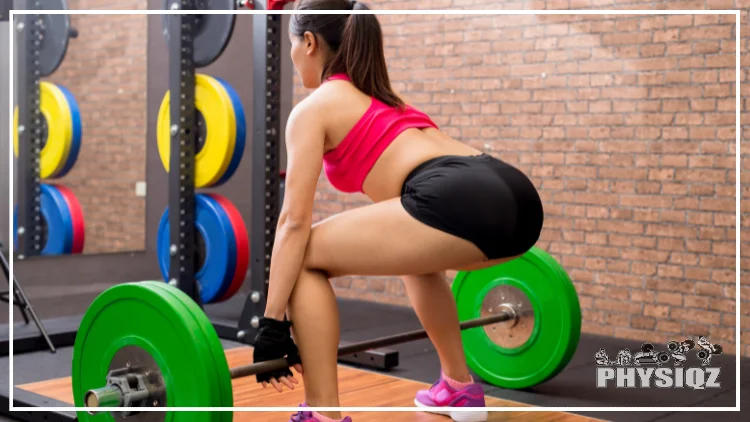
Source: RyanKing999 via Canva.com15
It is okay to focus on just the legs as first, but as results start to be noticeable, adding in a full body routine can be beneficial to make sure that the body has an even distribution of muscles.
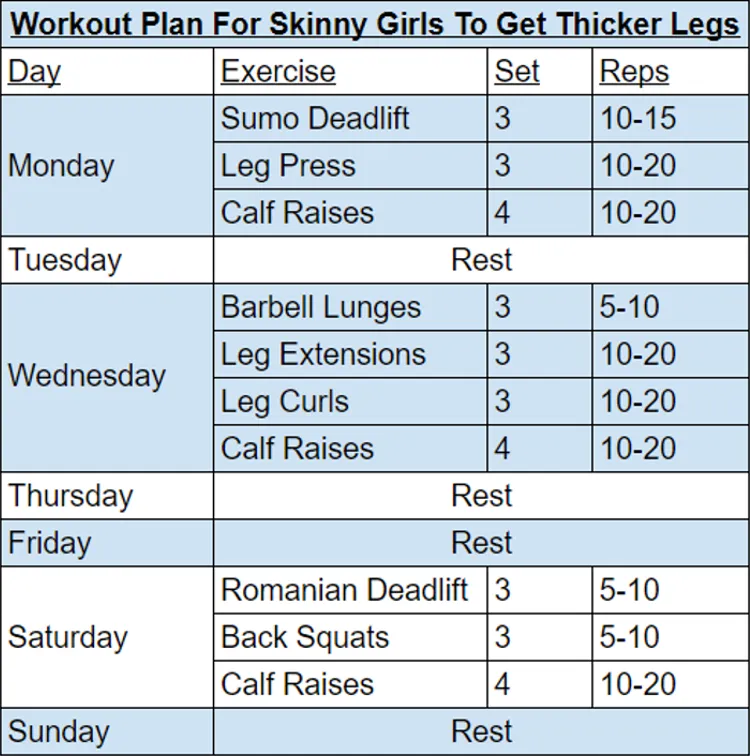
If following a certain plan or routine helps with motivation, there are several available to follow. Also, if legs are the focus, starting with just that portion of the program is also an option and after some time, transitioning into the full routine will be the most beneficial.
- PHAT Workout (Power Hypertrophy Adaptive Training)
- Starting Strength Routine
- Jason Blaha’s Ice Cream Fitness 5×5 Training Program for Novice and Intermediates
Why Won’t My Skinny Legs Get Bigger? Top Mistakes
It may seem like all the right things are being done but skinny legs just won’t get bigger. There are some top mistakes that keep skinny girls from bulking up their legs, so examining the list below can help correct these mistakes.
- Not Eating Enough: Make sure to get on the scale weekly to see if weight is being gained. If not, calories need to be increased or muscle growth will not happen.
- Incorrect Macros: Consider tracking food for a week or two to identify whether or not protein, carb, and fat goals are being met.
- Too Much Cardio: Cardio burns calories, so engaging in a large amount of these calorie burning activities can not only burn fat, but can also result in losing muscle mass.
- Weights Too Light: If sets are too easy, the weights being used aren’t heavy enough. Increase weight to make sets challenging but doable.
- Working Out Too Little: Muscles will not get the benefits of a workout if they aren’t worked out enough. Increase sets or days worked out.
- Muscles Aren’t Recovering: Rest and recovery is critical for muscle growth, so working out the same muscle groups day after day is fatiguing and can be counteractive to goals.
- Bad Leg Genetics: While bad leg genetics oftentimes refers to insertion points, it can also mean your quads, hamstrings or calves just don’t responded very well but there’s a few extra things that you can do to combat this.
Learn Effective Strategies for Skinny Girls to Increase Leg Muscle Mass Despite Genetics
Figuring out how to get bigger legs for females may feel like an uphill battle when battling bad leg genetics but overcoming skinny legs is possible. Concentrating on the below factors can ultimately can a woman where she wants to be.
Focus on mind muscle connection. This is how well you can feel a muscle contract during an exercise and it’s important because if you’re doing squats and all you feel is glutes, you could raise your heels to feel your quads more.
Modify exercises to focus on quads. One example is raising your heels as mentioned above, but another is to do leg extensions before squats to try and pre-fatigue your quads in order to feel them more.
Change up the intensity using various modalities and techniques. If you can’t feel your legs or they aren’t sore after, try a super set (one exercise back to back) of squats and lunges to see if that helps. There’s also drop sets where for example, you can do 50 lbs leg extensions for 10 reps, then drop down to 40 lbs for another 10 reps, and finish off with 30 lbs for the last 10 reps. You will feel the burn on these.
Be sure you’re working hard enough and getting close* to failure. You don’t want to go to failure (where you can’t do any more reps) on an exercise, but getting close to failure or an RiR (reps in reserve) of 1-3 is best for muscle growth. For more information, refer to our explanation of RiR and RPE in lifting.
All of these methods are generally overlooked when just beginning, but they’re a surefire way to override bad genetics and get those thick thunder thighs you dream of. Or in other words, thin and shapeless legs can be a thing of the past if the right steps are taken to grow muscles and bulk them up.
Gaining weight in the legs for a skinny girl involves a process, but these tips are ideal for building and maintaining a routine, helping nearly anyone achieve the goal of having beautiful and shapely thighs and calves.
References
1Prostock-studio. Canva. Accessed 15 April 2023. <https://www.canva.com/photos/MAEw0u1Ul_8-fitness-woman-doing-squat-at-home/>
2mediaphotos. Canva. Accessed 15 April 2023. <https://www.canva.com/photos/MAEEqtAPaDE-barbell-back-squat/>
3ображення користувача SerhiiBobyk. Canva. Accessed 15 April 2023. <https://www.canva.com/photos/MAEZOASzSgE-woman-doing-lunges-with-barbell/>
4Lund, Jacob. Canva. Accessed 15 April 2023. <https://www.canva.com/photos/MAC2BzPHLsE-cross-fit-woman-lifting-heavy-weights-in-gym/>
5Bordoni, B., & Varacallo, M. (2022, May 10). Anatomy, Bony Pelvis and Lower Limb, Thigh Quadriceps Muscle. NCBI. Retrieved December 8, 2022, from <https://www.ncbi.nlm.nih.gov/books/NBK513334/>
6vladimirsukhachev. Canva. Accessed 15 April 2023. <https://www.canva.com/photos/MAFQfn71lF0-young-smiling-woman-doing-leg-extension-in-exercise-machine-at-g/>
7Poudel, B., & Pandey, S. (2022, August 28). Hamstring Injury – StatPearls – NCBI Bookshelf. NCBI. Retrieved December 8, 2022, from <https://www.ncbi.nlm.nih.gov/books/NBK558936/>
8fotostorm. Canva. Accessed 15 April 2023. <https://www.canva.com/photos/MAEJBn0_ek8-focused-young-woman-doing-seated-leg-curls-on-exercise-machine/>
9grandriver. Canva. Accessed 15 April 2023. <https://www.canva.com/photos/MAEJO77OFBA-three-women-doing-calf-raises/>
10Goolsby, M. A. (2021, August 16). Overtraining: What It Is, Symptoms, and Recovery. HSS. Retrieved December 9, 2022, from <https://www.hss.edu/article_overtraining.asp>
11Israetel, M., Hoffmann, J., & Feather, J. (2017, January 4). Training Volume Landmarks for Muscle Growth. Renaissance Periodization. Retrieved December 9, 2022, from <https://rpstrength.com/training-volume-landmarks-muscle-growth/>
12U.S. Department of Health and Human Services. (n.d.). Body Weight Planner | NIDDK. National Institute of Diabetes and Digestive and Kidney Diseases. Retrieved December 9, 2022, from <https://www.niddk.nih.gov/bwp>
13Carbone, J. W., & Pasiakos, S. M. (2019, May 22). Dietary Protein and Muscle Mass: Translating Science to Application and Health Benefit. NCBI. Retrieved December 10, 2022, from <https://www.ncbi.nlm.nih.gov/pmc/articles/PMC6566799/>
14Israetel, M. (2020, October 3). Calories and Macros for Muscle Gain | Nutrition for Muscle Gain- Lecture 2. YouTube. Retrieved December 9, 2022, from <https://www.youtube.com/watch?v=gcUXMW0sWBA>
15RyanKing999. Canva. Accessed 15 April 2023. <https://www.canva.com/photos/MACgvDpAZ9U-woman-with-deadlift-squats/>